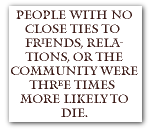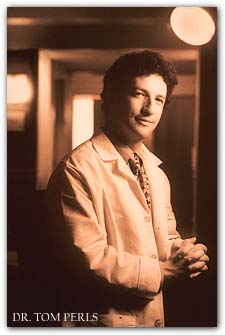Main Menu · Search ·Current Issue ·Contact ·Archives ·Centennial ·Letters to the Editor ·FAQs

"I often tell people that my grandmother lived to be 99," says
Marilyn Albert. "They would sometimes ask me if that was the reason
I decided to study aging and I would say, 'No.' I've since realized that
that's not true, that she probably was the reason."
Albert's grandmother, Rose Silbermann, was mentally intact until the day
she died. She was interested in the world, Albert recalls, liked to talk
about everything that was going on in her family, and determinedly and admirably
independent. Albert remembers the home-cooked food her grandmother would
unpack after bringing it from the Bronx to Manhattan on the subway. After
her husband died, she lived on her own until three months before her own
death. "I always felt comfortable with her," Albert says. "She
looked very old but she was comfortable with herself and that comfort put
me at ease. This ingrained in me that aging was something positive."
 More and more researchers are looking to the Rose Silbermanns of the world
for information about successful aging. She, Henrietta Aladjem, and Ruth
McShane sound so unusual because they defy our notions about aging. Although
about 1.7 million Americans live in nursing homes, they constitute only
4.5 percent of the over-65 population. The rest of the elderly live in homes:
houses, apartments, retirement communities, with in-laws, or in assisted-living
facilities. However you count them, the vast majority of elderly are noninstitutionalized
participants in society, albeit with widely varying degrees of independence.
More and more researchers are looking to the Rose Silbermanns of the world
for information about successful aging. She, Henrietta Aladjem, and Ruth
McShane sound so unusual because they defy our notions about aging. Although
about 1.7 million Americans live in nursing homes, they constitute only
4.5 percent of the over-65 population. The rest of the elderly live in homes:
houses, apartments, retirement communities, with in-laws, or in assisted-living
facilities. However you count them, the vast majority of elderly are noninstitutionalized
participants in society, albeit with widely varying degrees of independence.
In the early 1980s, when the MacArthur Foundation decided to devote funding
to studies of successful aging, Albert, Jack Rowe, and Lisa Berkman (now
Norman professor of health, social behavior, and epidemiology at the Harvard
School of Public Health), were some of the first researchers to become involved.
The results of a recently released collaborative study draw strong connections
between preserved cognitive function-an important component of successful
aging-and education, physical activity, and lung function.
 Although the link between education and successful aging seems firm, its
implications are not entirely clear. It is possible that higher education
could substitute for environmental factors the study didn't measure, such
as better health care. Or perhaps formal schooling enables people to perform
better on tests. The explanation Albert feels is most plausible is that
mental activity produces lasting change in the brain itself-proliferation
of nerve cells, for example-that may serve the brain in good stead in years
to come. "Just having more synapses may make the brain more resilient
to stress, even the stress of cognitive degeneration," she says. "This
change may be produced by education early in life, but we hope it also is
effected by lifelong habits of mental activity."
Although the link between education and successful aging seems firm, its
implications are not entirely clear. It is possible that higher education
could substitute for environmental factors the study didn't measure, such
as better health care. Or perhaps formal schooling enables people to perform
better on tests. The explanation Albert feels is most plausible is that
mental activity produces lasting change in the brain itself-proliferation
of nerve cells, for example-that may serve the brain in good stead in years
to come. "Just having more synapses may make the brain more resilient
to stress, even the stress of cognitive degeneration," she says. "This
change may be produced by education early in life, but we hope it also is
effected by lifelong habits of mental activity."
That's a small piece in a larger puzzle. "Normal, successful aging
is an interesting and vital way to study the aging process," says the
medical school's Ken Minaker. "We're focused on provoking the system,
stressing it, and then watching it recover. For example, in the elderly,
there's an erosion of capacity to tolerate extremes of too much or too little
salt. Older patients are frequently on the brink of over- or under-hydration.
Under these conditions, simple illnesses such as a mild fever can precipitate
severe dehydration."
In one set of experiments, Minaker looked at the capacity of elderly people
to regulate fluid and electrolyte balance in their bodies. This is a common
source of problems; dehydration costs some $400 million to $600 million
in hospitalization and treatment each year, primarily among the elderly.
In some cases, people become disoriented and may temporarily appear demented.
"What we've found," says Minaker, "is that in adapting to
different conditions, elderly people 'get there'-they make the adjustment-but
it takes them more time and they do it by different mechanisms than younger
people."
If you've ever watched an older tennis player on the court, you can visualize
what he is talking about. Lost mobility encourages restraint. Players learn
that if they take fewer chances, they stand a much better chance of returning
the next volley. Likewise, the body learns that recovery from stress is
a process best undertaken cautiously, with one eye toward what's coming
next.
"There's a tendency to muddle through," Minaker says. "I
think that advancing age means adapting to limits on maximum capacities
that allow people to adjust, but without doing self-damage. Physiologically,
age is a time of adaptation, when compensatory mechanisms adjust in order
to fight off challenges and keep self-regulated. You can't tolerate severe
challenges, but for little hits you manage pretty well."
As a result, the aging body seems capable of much more than has been widely
acknowledged. In many cases, it's not the depredations of aging itself that
cause disease, but factors outside the body: infection, behaviors like diet,
smoking, lack of exercise, and the social environment. And most of these
factors can be modified; they don't bear the permanent stamp of genetic
birthright.
More signs on the route to successful aging come from the interface of social
sciences and medicine. It's now becoming clear that keeping up social connections
and interpersonal contacts-friends, family, and community-matters as much
as mental and physical fitness. Lisa Berkman began thinking about this issue
when she worked at a family-planning clinic in San Francisco. She observed
what she was later to call "a protective web of social networks."
"It struck me that those people who were most disconnected and socially
isolated were vulnerable, and were in trouble across a lot of domains,"
recalls Berkman. "On the other hand, people who were really connected
to their communities were doing really well."
She decided to investigate the connection further, despite the obvious pitfalls
of looking for connections between health and such hard-to-define variables
as social support. Her research demonstrated that people with no close ties
to friends, relations, or the community were three times more likely to
die over a nine-year period than those with at least one source of social
support.
"It's clearly a two-way street," says Berkman, now chair of the
School of Public Health's department of health and social behavior. "It's
clear that people by the nature of their illness undergo social and psychological
changes that are consequences of illness, like the loss of social contacts.
However, it also seems that social circumstances like isolation precede
and predict the onset and course of illness. My question was, how could
something that's 'outside' your body-like social support-get 'inside,' and
what are the pathways through which it could get inside?"
Berkman is forging the next link by looking for the biochemical effects
that social contacts might have. She's focusing on levels of hormones that
increase in response to stress; repeated exposure to these hormones may
leave elderly people more vulnerable to all types of illnesses, such as
heart disease. She is also testing interventions to see if prognoses may
be improved with alterations in social support.
"People thought it was normal to experience health and functional declines
with age and that it was all determined by genes," Berkman says. "Today,
more people recognize that the key to aging is in large part related to
conditions we can do something about, like the social environment, behaviors,
health practices, and kinds of experiences we have in midlife. The key to
extending life lies in genes and in how we're living."
